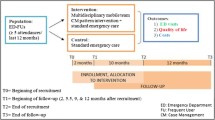Abstract
Objectives: to evaluate the proportion of the patients who report the emergency department as their regular source of care and to describe the demographics and health status of this population. Design: A cross-sectional study was performed at the emergency department in two hospitals (around 12.000 visits per year each). Subjects were interviewed using a standardised questionnaire, before and after the emergency department visit. Setting: The medical emergency department of two university hospitals, one in Paris and one in Besanìon (France). Subjects: Each patient aged 15 and more attending the emergency department for a visit during forty randomly selected periods of 12 hours was included. Main outcome measures: Self report of the utilization of the emergency department as a regular source of care. Results: Fourteen percent of the patients cited the emergency department as a regular source of care in Paris, and 3.3% in Besanìon. In Paris, young age, being born outside of France, homelessness or precarious housing, lack of social support in case of illness and lack of health insurance were independently associated with his health care utilization behavior. Conclusions: From a public health point of view, the patients reported to use the emergency department as a primary health care structure should not be considered as ‘inappropriate’ or ‘abusers’. Specific health needs have been found, which would require some continuity of care, a task for which the emergency department is not organised nowadays.
Similar content being viewed by others
References
Leclerc A, Lert F, Fabien C. Differential mortality: some comparisons between England and Wales, Finland and France, based on inequality measures. Int J Epidemiol 1990; 19: 1001–1010.
Kunst AE, Mackenbach JP. The size of mortality differences associated with educational level in nine industrialized countries. Am J Publ Hlth 1994; 84: 932–937.
Desplanques G. L'inégalité sociale devant la mort. In: Bouvier-Colle MH, Vallin J, Hatton F, eds, Mortalité et causes de décès en France. INSERM Ed. Paris, 1990: 257–287.
Lang T, Ducimetière P. Premature cardiovascular mortality in France: divergent evolution between social categories from 1970 to 1990. Int J Epidemiol 1995; 24: 331–339.
Baker DW, Stevens CD, Brook RH. Regular source of ambulatory care and medical care utilization by patients presenting to a public hospital emergency department. JAMA 1994; 271: 1909–1912.
Hayward R, Bernard A, Freeman H, Corey C. Regular source of ambulatory care and access to health services. Am J Public Health 1991; 81: 434–435.
Purdie F, Honigman B, Rosen P. The chronic emergency department patient. Ann Emerg Med 1981; 10: 298–301.
Hansagi H, Edhag O, Alleback P. High consumer of health care in an emergency unit: how to improve their quality of care. Qual Insur Health Care 1991; 3: 51–62.
Gaussens E. Les urgences à Paris: bilan du plan urgence de l'Assistance Publique-Hôpitaux de Paris. Techn Hosp 1993; No. 578: 21–35.
Steg A. L'urgence à l'hôpital. Rapport présenté au Conseil économique et social. Séances des 11 et 12 Avril 1989. Journal Officiel de la République française, No. 4123.
Lang T, Davido A, Diakité B, Agay E, Viel JF, Flicoteaux B. Non urgent care in the hospital medical emergency department: How much and which health needs does it reflect? J Epidemiol Comm Health 1996; 50: 456–462.
INSEE. Nomenclature des Professions et Catégories Socio-professionnelles. Paris: INSEE, 1993.
Jamoule M, Roland M. Classification internationale des soins primaires. Lyon: Lacassagne Ed., 1992, 293 p.
SAS User's Guide: Statistics. Version 6, 4th edition. Cary NC, USA, 1990.
Grumbach K, Keane D, Bindman A. Primary care and public emergency department overcrowding. Am J Publ Health 1993; 83: 372–378.
Aday LA, Andersen RM. The national profile of access to medical care: where do we stand? Am J Publ Health 1984; 74: 1331–1339.
Dale J, Green J, Reid F, Glucksman E. Primary care in the accident and emergency department: I Prospective identification of patients. Br Med J 1995; 311: 423–426.
Derlet RW, Nishio DA. Refusing care to patients who present to an emergency department. Ann Emerg Med 1993; 19: 262–267.
Rodwin RG, Sandier S. Health care under French national health insurance. Health Affairs 1993; 1: 111–131.
Bajos N. Les logiques sociales et instutionnelles de l'aide médicale urgente extra-hospitalière à Paris. Analyse de l'activité de la brigade de Sapeurs Pompiers de Paris et du S.A.M.U de Paris. PhD Dissertation, University Paris-Sud, 1993, 200 p.
Shesser R, Kirsch T, Smith J, Hirsch R. An analysis of emergency department use by patient with minor illness. Ann Emerg Med. 1991; 20: 743–748.
Malone RE. Heavy users of emergency services: social construction of a policy problem. Soc Sci Med 1995; 40: 469–477.
Shea S, Misra D, Ehrlich MH, Field L, Francis CK. Predisposing factors for severe, uncontrolled hypertension in an inner-city minority population. N Engl J Med 1992; 327: 776–781.
Lang T, Lombrail P, Fouriaud C, Jacquinet-Salord MC, Mahé I. Hôpital, médecine du travail et correction des inégalités dans le domaine de la prévention. Rev Epidém et Santé Publ 1990; 38: 281–286.
Levine DM, Becker DM, Bone LR, Hill MN, Tuggle MB, Zeger SL. Community-Academic Health Center Partnerships for underserved Minority Populations. JAMA 1994; 272: 309–311.
Author information
Authors and Affiliations
Rights and permissions
About this article
Cite this article
Lang, T., Davido, A., Diakité, B. et al. Using the hospital emergency department as a regular source of care. Eur J Epidemiol 13, 223–228 (1997). https://doi.org/10.1023/A:1007372800998
Issue Date:
DOI: https://doi.org/10.1023/A:1007372800998




